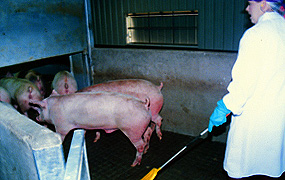Preventing Bloodsplash (Bloodspots)
(Updated August 2000)
These principles apply to both manual and automatic electric stunners.
- Handle animals gently. Gentle
handling prevents damage to small blood vessels caused by excited animals
jamming against each other or equipment. Electric prod usage should be
kept at a minimum.

Plastic paddles work well for moving pigs instead of electric
prods. Flags also work well for moving pigs.
- Animals should never be left in the restrainer system
during breaks and lunch. Bloodsplash may also be increased if one side of
a V restrainer runs faster than the other. This causes stretching of the
skin which damages blood vessels. Both sheep and pigs should be bled
within 15 seconds after stunning to minimize meat damage. The slats on
the V restrainer and hold-down rack should be insulated to prevent current
leakage which can cause bloodsplash.
- Rapid temperature fluctuations and periods of extremely hot weather
can greatly increase the incidence of bloodsplash. In these
circumstances, plants should take extra care in handling animals to
minimize bloodsplash problems.
- Use a constant amperage stunning circuit which holds the amperage
constant at 1.25 amps for pigs, 1 amp for sheep, and 2.5 amps for cattle. These are the minimum amperage levels which will reliably induce unconsciousness. For large sows use 2 or more amps.
- Use good stunning practices. Keep stunner contacts clean and avoid
sliding the stunner wand on the animal during the stun.
- Do not place an energized electrode against the animal. This will cause a double muscle contraction which will increase bloodsplashing. The electrodes should be pressed firmly against the animal BEFORE they are energized. If a pig squeals when the electrode is applied, bloodsplash may increase.
- Replace switches often. Carbonized or dirty switches may cause amperage or voltage fluctuations which may increase bloodsplash.
- Replace cords and wiring often. Constant flexing of the wires as each animal is stunned breaks small wire strands inside the cable. Broken strands may cause amperage or voltage fluctuations.
- Keep electrical junction boxes dry.
- The animal must be wet enough to make a good electrical contact, but not so wet that dripping water shorts out the stunner.
- Bars mounted over the top of the race and restrainer should NOT touch the animal's back.
- Calm animals are easier to stun than excited animals. Use careful, quiet handling methods.
- Nutrition can affect susceptibility to bloodsplash. Animals that feed on anticoagulants such as clover may have more bloodsplash. Young animals and lean pigs are more susceptible than older animals.
- Changing the 50 to 60 cycles (Hz) electrical frequency may reduce bloodsplash. Frequencies higher than 1500 cycles must NOT be used because they may NOT make the animal unconscious. One problem with high frequency stunning is increased kicking. In pigs, kicking can be stopped by applying a 50-60 cycle cardiac arrest stun after the initial high frequency head stun. Frequencies of up to 800 cycles (Hz) will work in a commercial pork slaughter plant.
- An overworked or fatigued operator will cause increased levels of bloodsplash because the electrodes will not be placed correctly. In large plants, bloodsplash may increase within 2 hours unless the operators are rotated.
- Continually audit stunning practices. People manage the things that they measure. Stunning practices and bloodsplash must be continually measured to maintain both good animal welfare and low levels of bloodsplash.
- When head to body cardiac arrest stunning is used on sheep, hide (pelt) damage can be prevented by applying the body electrode first and the head electrode second.
References :
 Grandin, T. (1995)
Getting Rid Of Bloodsplash
Grandin, T. (1995)
Getting Rid Of Bloodsplash
Meat and Poultry October page 16
 Grandin, T. (1994)
Grandin, T. (1994)
Euthanasia and Slaughter of
Livestock
Journal of American Veterinary Medical
Association
volume 204 : 1354 - 1360
 Grandin, T.(1994)
Grandin, T.(1994)
Methods to reduce PSE and
bloodsplash
Allen D. Leman Swine
Conference Volume 21 pages 206-209
College of Veterinary Medicine,
University of Minnesota.
 Grandin, T.(1988)
Grandin, T.(1988)
Environmental Enrichment for
Confinement Hogs
Livestock Conservation
Institute Annual Meeting Proceedings pages 119-123
1910 Lyda Drive
Bowling Green, Kentucky 42104-5809
 Click here to return to the Homepage for more information on animal behavior, welfare, and care.
Click here to return to the Homepage for more information on animal behavior, welfare, and care.


Grandin, T. (1995)
Grandin, T. (1994)
Grandin, T.(1994)
Grandin, T.(1988)
 Click here to return to the Homepage for more information on animal behavior, welfare, and care.
Click here to return to the Homepage for more information on animal behavior, welfare, and care.